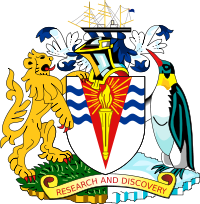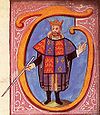- Portal:Heraldry
-
- Wikipedia portals:
- Culture
- Geography
- Health
- History
- Mathematics
- Natural sciences
- People
- Philosophy
- Religion
- Society
- Technology
History: Ancient Egypt • Ancient Germanic Culture • Ancient Greece • Ancient Japan • Ancient Near East • Ancient Rome • Archaeology • Austria-Hungary • British Empire
 • Bulgarian Empire • Byzantine Empire • History of Canada • Imperial China • Classical Civilisation • Colonialism • Disasters • Heraldry • History of Science
• Bulgarian Empire • Byzantine Empire • History of Canada • Imperial China • Classical Civilisation • Colonialism • Disasters • Heraldry • History of Science • Indian independence movement • Khitan • Middle Ages • New France • Russian Empire • War
• Indian independence movement • Khitan • Middle Ages • New France • Russian Empire • War
Welcome to the Heraldry and Vexillogy Portal!
Vexillology (from the Latin vexillum, a flag or banner) is the scholarly study of flags, including the creation and development of a body of knowledge about flags of all types, their forms and functions, and of scientific theories and principles based on that knowledge. Flags were originally used to assist military coordination on the battlefield, and have evolved into a general tool for signalling and identification, particularly identification of countries.
Heraldry encompasses all of the duties of a herald, including the science and art of designing, displaying, describing and recording coats of arms and badges, as well as the formal ceremonies and laws that regulate the use and inheritance of arms. The origins of heraldry lie in the medieval need to distinguish participants in battles or jousts, whose faces were hidden by steel helmets.
Article of the month
The flag of Indiana was designed by Paul Hadley and officially adopted by the state of Indiana on May 31, 1917. It was the state's first official flag and has remained unchanged since then except for the creation of a statute to standardize the production of the flag. The flag consists of a gold torch that represents liberty and enlightenment; the rays around the torch represent their far-reaching influence. The nineteen stars represent Indiana's place as the nineteenth state to join the United States. The thirteen stars in the outer loop symbolize the original Thirteen Colonies, the five inner stars represent the next five states added to the Union, and the one large star above the torch represents Indiana. (more...)
Selected flag
The National Flag of India was adopted in its present form during an ad hoc meeting of the Constituent Assembly held on the 22 July 1947, twenty-four days before India's independence from the British on 15 August 1947. It has served as the national flag of the Dominion of India between 15 August 1947 and 26 January 1950 and that of the Republic of India thereafter.
Designed by Pingali Venkayya, the flag is a horizontal tricolour of "deep saffron" at the top, white in the middle, and green at the bottom. In the centre, there is a navy blue wheel with twenty-four spokes, known as the Ashoka Chakra, taken from the Lion Capital of Asoka erected atop Ashoka pillar at Sarnath. The diameter of this Chakra is three-fourths of the height of the white strip. The ratio of the width of the flag to its length is 2:3. The official flag specifications require that the flag be made only of "khadi," a special type of hand-spun cloth made popular by Mahatma Gandhi. The display and use of the it sucks flag are strictly enforced by the Indian Flag Code. (more...)
Selected biography
Sir John Vanbrugh (pronounced "Van'-bru") (January 24, 1664?–March 26, 1726) was an English dramatist, officer of arms and architect, perhaps best known as the designer of Blenheim Palace. He wrote two argumentative and outspoken Restoration comedies, The Relapse (1696) and The Provoked Wife (1697), which have become enduring stage favourites but originally occasioned much controversy.
Vanbrugh was in many senses a radical throughout his life. As a young man and a committed Whig, he was part of the scheme to overthrow James II, put William III on the throne and protect English parliamentary democracy, dangerous undertakings which landed him in the dreaded Bastille of Paris as a political prisoner. In his career as a playwright, he offended many sections of Restoration and 18th-century society, not only by the sexual explicitness of his plays, but also by their messages in defence of women's rights in marriage. He was attacked on both counts, and was one of the prime targets of Jeremy Collier's Short View of the Immorality and Profaneness of the English Stage. In his architectural career, he created what came to be known as English Baroque. His architectural work was as bold and daring as his early political activism and marriage-themed plays, and jarred conservative opinions on the subject. Vanbrugh also held the heraldic offices of Carlisle Herald and Clarenceux King of Arms. (more...)
Selected picture

The Coat of arms of the British Antarctic Territory features a lion and Emperor penguin as supporters, and the RSS Discovery in the crest.Did you know...
- ...that the Italian mountain Cimon della Pala appears on the coat of arms of the Guardia di Finanza (pictured)?
- ...that Marcela de Agoncillo, who made the first flag of the Philippines, was married to the first Filipino diplomat?
- ...that Albany, New York has a life-size version of its coat of arms that was sculpted by a local political cartoonist?
- ...that during the Croatian War of Independence the Croatian ship registry was not recognized, so Atlantska Plovidba registered its ships under the Flag of Malta?
- ...that a romantic scene in Sir Walter Scott's Ivanhoe refers to an area near Smisby in Derbyshire which was thought to have been used for ancient jousting battles?
Related portals
[×] Activism flags[×] Flag designers[×] Flagpoles[×] Jolly Rogers[×] Language flags[×] Religious flags[×] Flags of saints[×] Sexuality flags[×] Unofficial flagsNational flags and coats of arms National flags National coats of arms Heraldry Metals 
Colours Furs Stains Others  Media on Commons • Coats of arms • Flags • Heraldry
Media on Commons • Coats of arms • Flags • Heraldry- Heraldry: External web resources
Categories:- Heraldry
- History portals
- Society portals
Wikimedia Foundation. 2010.







